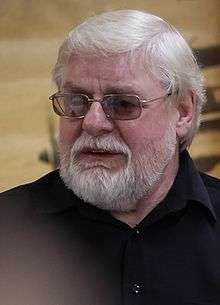Valentin Dikul
Valentin Ivanovich Dikul (Russian: Валентин Иванович Дикуль; born 3 April 1948) is a circus artist and rehabilitation specialist. He is a People's Artist of Russia (1999) and the head of the Russian medical and rehabilitation center of the musculoskeletal system diseases.[2]
Valentin Dikul | |
|---|---|
 Dikul in 2011 | |
| Born | 3 April 1948 (age 72) Kaunas, Lithuanian SSR, Soviet Union |
| Occupation | Circus artist, rehabilitation specialist |
| Known for | Dikul rehabilitation center |
| Awards | People's Artist of Russia (1999)[1] |
Biography
Dikul was born prematurely, weighing just over one kilogram. His father Ivan (1920–1950) was shot dead by bandits, and his mother Anna (1925–1952) died when Valentin was still in kindergarten.[3] Dikul was raised by his grandparents until he was seven years old, when he began living in orphanages, first in Vilnius and then in Kaunas. Aged nine, he became interested in the circus and helped to put up the circus tent, cleaning the arena, looking after the animals, sweeping, and washing the floors. At fourteen he began working as a motorcycle repairman. In his free time he trained in gymnastics, wrestling, weightlifting, balancing acts, acrobatics, juggling, and stunts, and eventually became involved with the circus in Kaunas.[3]
Injury
In 1962, when Valentin was almost fifteen, he starred in his first act of air gymnastics at the Sports Palace. The act was performed at an altitude of 13 meters.[3] During one such performance, a steel support cross beam suddenly broke, and Valentin fell from 13 meters. He spent a week in intensive care at the City Hospital and was then transferred to the neurosurgery department of the hospital. His final diagnosis was a compression fracture of the lumbar spine and traumatic brain injury, with many local fractures.[3]
Recovery
Dikul trained for 5–6 hours a day lifting objects, stretching rubber bands and performing push-ups; however, his legs did not work. Suffering from pain in the spine and fatigue, he performed strength exercises and studied the medical literature on the spine, gathering the necessary information. Doctors asked him to stop wasting time and effort, explaining that success is impossible. But he continued to exhaustion. He began to lift weights small at first, then more and more increasing the weight, developing all the muscles of the back which he was able to. Then he had the idea that you need to move the inactive parts of the body as if they were healthy a full cycle[4]. Tied a rope to his feet, passing it under the headboard, which played the role of the pulley and then pulling it and moving the feet. Then he began using counterweight loads. Friends helped him build a system of weights and pulleys around his bed designed by Dikul. Eight months later he was discharged from the hospital with the first group of disability.[3]
A series of publications in the press provoked an avalanche of letters to Dikul with requests for help. In response, he would send them a package of instructions designed for medical rehabilitation. In processing a large amount of correspondence he was helped by his wife Lyudmila.
Many people confined to a wheelchair, saw it as their hope. Valentin spent three to four hours a day on advising people with disabilities.[4]
In 1988, the Dikul center, a Russian rehabilitation center for patients with spinal injuries and with consequences of infantile cerebral paralysis, was opened.[4]
References
- Указ Президента РФ от 17.06.1999 N 786 "О награждении государственными наградами Российской Федерации". kremlin.ru
- V. V. Akatova. ДИ́КУЛЬ Валентин Иванович. Great Russian Encyclopedia
- Биография Валентина Дикуля. RIA Novosti. 3 April 2013
- Система Валентина Дикуля. paralife.narod.ru
External links
| Wikimedia Commons has media related to Valentin Dikul. |